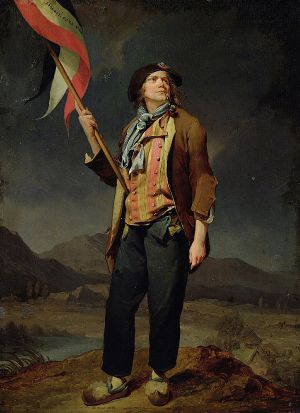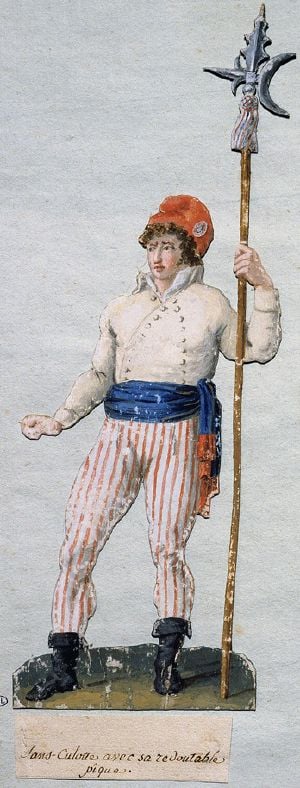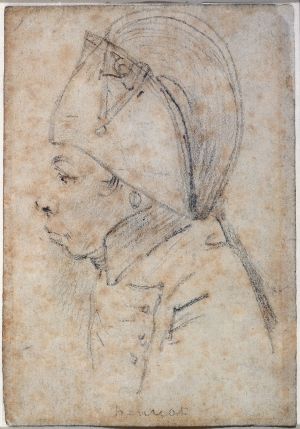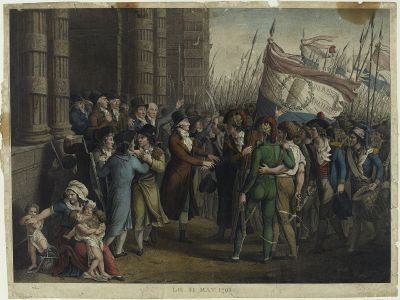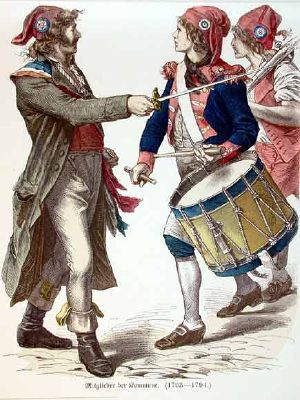Sans-culottes
The sans-culottes (French pronunciation: [sɑ̃kylɔt], literally "without breeches") were the common people of the lower classes in late eighteenth-century France. The name sans-culottes refers to their clothing, and through that to their lower-class status: culottes were the fashionable silk knee-breeches of the eighteenth-century nobility and bourgeoisie. The working class sans-culottes wore pantaloons, or long trousers instead. Sans-culottes meant "ordinary patriots without fine clothes," and referred to the fancy clothes that famous patriots wore. They wore pants with cuffed, rolled up bottoms.
The sans-culottes, most of them urban laborers, served as the driving popular force behind the revolution. They were among the more radical elements, advocating for wage and price controls and comprising most of the revolutionary army that served as the executioners of the Reign of Terror. They played a significant role as radical and militant partisans of the French Revolution.
Origins and Appearance
The word sans-culottes seems to have been used for the first time on February 28, 1791 by Jean-Bernard Gauthier de Murnan in a derogatory sense, speaking about a "sans-culottes army".[1] The word came into vogue during the demonstration of 20 June 1792.[2]
The distinctive costume of typical sans-culottes featured:
- the pantalon (long trousers) – in place of the culottes (silk knee-breeches) worn by the upper classes[3]
- the carmagnole (short-skirted coat)
- the sabots (a type of wooden clog) and
- the red Phrygian cap, also known as a "liberty cap"
Political ideals
The sans-culottes were the urban workers, largely peasants who had come to the cities to work. They were especially hurt by a hail storm which damaged grain crops in 1788, which caused bread prices to skyrocket.[4] While the peasants of rural France could sustain themselves with their farms, and the wealthy aristocracy could still afford bread, the urban workers in large cities, the group that comprised the sans-culottes, suffered. In the city, the division grew between the sans-culottes and these wealthy aristocrats; the former had a particular hostility "towards those with large private incomes."[5]
The most fundamental political ideals of the sans-culottes were social equality, economic equality, and popular democracy. They supported the abolition of all the authority and privileges of the monarchy, nobility, and Roman Catholic clergy, the establishment of fixed wages, the implementation of price controls to ensure affordable food and other essentials, and vigilance against those deemed as counter-revolutionaries.[6]
They expressed their demands through petitions of the sections presented to the assemblies (the Legislative, and Convention) by the delegates. The sans-culottes had a third way of applying pressure to achieve their demands: the police and the courts received thousands of denunciations of traitors and supposed conspirators.[7] The height of their influence spanned roughly from the original overthrow of the monarchy in 1792 to the Thermidorian Reaction in 1794. Throughout the revolution, the sans-culottes provided the principal support behind the more radical and anti-bourgeoisie factions of the Paris Commune, such as the Enragés and the Hébertists, and were led by populist revolutionaries such as Jacques Roux and Jacques Hébert.
In the summer of 1793 the sans-culottes, the Parisian enragés especially, accused even the most radical Jacobins of being too tolerant of greed and insufficiently universalist. From this far-left point of view, all Jacobins were at fault because all of them tolerated existing civil life and social structures.[8]
The sans-culottes also populated the ranks of paramilitary forces charged with physically enforcing the policies and legislation of the revolutionary government, a task that commonly included violence and the carrying out of executions against perceived enemies of the revolution.
During the peak of their influence, the sans-culottes were held up as living representations of the revolutionary spirit. During the height of revolutionary fervor, such as during the Reign of Terror when it was dangerous to be associated with anything counter-revolutionary, even public functionaries and officials actually from middle or upper-class backgrounds adopted the clothing and label of the sans-culottes as a demonstration of solidarity with the working class and patriotism for the new French Republic.
1791-1793
On April 27, 1791 Robespierre opposed plans to reorganize the National Guard and restrict its membership to active citizens, men over 25 years of age who paid direct taxes equal to three days labor.[9] He demanded the reconstitution of the army on a democratic basis[10] to allow passive citizens to join. He felt that the army had to become the instrument of defense of the Revolution and no longer be a threat to it. On April 28, despite Robespierre's intensive campaign, the principle of an armed bourgeois militia was enacted in the Assembly.[11]
Along with other Jacobins, he urged in his magazine the creation of an "armée révolutionnaire" in Paris, consisting of 20,000 men,[12] with the goal to defend "liberty," maintain order in the sections and educate the members in democratic principles-an idea he borrowed from Jean-Jacques Rousseau and Machiavelli.[13] According to Jean Jaures, he considered this even more important than the right to strike.[10]
Following the king's veto of the Assembly's efforts to raise a militia of volunteers, the reinstatement of Brissotin ministers and suppression of non-juring priests, the monarchy faced an abortive Demonstration of 20 June 1792.[14] Sergent-Marceau and Panis, the administrators of police, urged the sans-culottes to lay down their weapons, telling them it was illegal to present a petition in arms, although their march to the Tuileries was not banned. They invited the officials to join the procession and march along with them.[15]
Early in the morning (August 10, 1792) 30,000 Fédérés, and sans-culottes militants from the sections led a successful assault upon the Tuileries, according to Robespierre a triumph for the "passive" citizens. Sulpice Huguenin, head of the sans-culottes in the Faubourg Saint-Antoine, was appointed provisional president of the Insurrectionary Commune.
In Spring 1793, after the defection of General Dumouriez to the Austrians, Robespierre urged the creation of a "sans-culottes army" to sweep away any conspirator.[16]
On May 1 the crowds threatened armed insurrection if the emergency measures demanding price controls were not adopted. On May 8 and 12, Robespierre repeated in the Jacobin Club the necessity of founding a revolutionary army consisting of sans-culottes, paid by a tax on the rich, to beat the aristocrats inside France and the Convention. Every public square should be used to produce arms and pikes.[17] On May 18 Marguerite-Élie Guadet proposed to examine the "exactions" and to replace municipal authorities.[18][19]
As rioting persisted a commission of inquiry of twelve members, with a very strong Girondin majority, was set up to investigate the anarchy in the communes and the activities of the sans-culottes. On May 28 the Paris Commune accepted the creation of a sans-culottes army to enforce revolutionary laws.[20] Petitioners from the sections and the Commune appeared at the bar of the Convention at about five o'clock in the afternoon of May 31. They demanded that a domestic revolutionary army should be raised and that the price of bread should be fixed at three sous a pound, that nobles holding senior rank in the army should be dismissed, that armories should be created for arming the sans-culottes, the departments of State purged, suspects arrested, the right to vote provisionally reserved to sans-culottes only, and a fund set apart for the relatives of those defending their country and for the relief of aged and infirm.[21][22][23] According to Hampson, the subject is quite extraordinarily complicated and obscure and has not been fully investigated.[24] The next day all Paris was in arms.
Hanriot was ordered to march his National Guard, by this time mostly consisting of sans-culottes, from the town hall to the Palais National.[25] On June 2, 1793 a large force of reportedly 80,000 sans-culottes and National Guards led by Hanriot, surrounded the convention with 160-172 guns.
1793-1794
On September 4, the sans-culottes again invaded the convention. They demanded tougher measures against rising prices and the setting up of a system of terror to root out the counter-revolution.[26] The sans-culottes took an especially active interest in the revolutionary army.[27]
A sans-culottes army[28]) was formed in Paris. These were a force of citizen-soldiers that could go into the countryside to supervise the requisition of grain, to prevent the maneuvers of rich égoistes and deliver them up to the vengeance of the laws.[29])
Barère voiced the Committee of Public Safety's support for the measures desired by the assembly. He presented a decree that was passed immediately, establishing a paid armed force of 6,000 men and 1,000 gunners "designed to crush the counter-revolutionaries, to execute wherever the need arises the revolutionary laws and the measures of public safety that are decreed by the National Convention, and to protect provisions (A force of citizen-soldiers which could go into the countryside to supervise the requisition of grain, to prevent the maneuvers of rich égoistes and deliver them up to the vengeance of the laws."[30]) For that reason, twelve traveling tribunals (with moveable guillotines) were set up.
Three months later, on December 4, the departmental armées revolutionnaires (except in Paris) were banned on proposal of Tallien.[31][32][33] The sections lost all rights to control their delegates and officials.
On March 4, 1794, there were rumors of uprising in the Cordeliers Club. The Hébertists hoped that the National Convention would expel Robespierre and his Montagnard supporters.[34] The sans-culottes did not respond and Hanriot refused to cooperate. On March 13 Hébert, the voice of the sans-culottes, used the latest issue of his newspaper, Le Père Duchesne, to criticize Robespierre. On March 18 Bourdon attacked the Commune and the sans-culottes army. (Ronsin, Vincent, Momoro, Clootz, etc.) were arrested on charges of complicity with foreign powers, (William Pitt the Younger) and others, and guillotined on March 24. On March 27 the infantry and cavalry of the armée revolutionnaire,[35] active for eight months in Paris and surroundings, was finally disbanded, except their artillery.[36][37] Hanriot was denounced by the Revolutionary Tribunal as an accomplice of Hébert, but seems to have been protected by Robespierre.[38]
Montagnard influence
The Montagnards represented the interests of the urban poor.[39] When the National Convention met to discuss the fate of the former king Louis XVI in 1792, the sans-culottes vehemently opposed a proper trial, instead opting for an immediate execution. The moderate Girondin faction voted for a trial, but the radical Montagnards sided with the sans-culottes, deeming that a trial was not necessary, and won with a slim majority. Louis XVI was executed on January 21, 1793.[40]
The demands of the sans-culottes did not stop with the execution of the King. This increased pressure from the radical masses exacerbated the ideological split between the Montagnards and the Girondins, and tensions began to grow within the convention.[41] Eventually, by May 1793, the Montagnards worked with the National Guard—which was, at this time, mostly sans-culottes—to depose many of the Girondin deputies. "The Montagnards and the sans-culottes surrounded the Convention, and two days later the intimidated assembly suspended twenty-nine Girondin deputies. The defeated Girondin leaders were arrested, although some escaped and fled to the provinces, but most were caught and executed or committed suicide. The Montagnards were left in control of the Convention, which itself was clearly at the mercy of whoever could command the armed sans-culottes battalions."[42] Now, whoever was in control of France's destiny had to answer to the sans-culottes, who "effectively exercised legislative power" in situations of unrest.[43] Otherwise, they would risk a similar uprising and their own exile, or possibly execution. This political shift towards radicalism would soon play a key role in the Reign of Terror.
Reign of Terror
Though ill-clad and ill-equipped, with little or no support from the middle and upper classes, the sans-culottes made up the bulk of the Revolutionary army and were responsible for many executions during the early years of the French Revolutionary Wars.[44] The mass violence of the sans-culottes created a lasting impact during the Reign of Terror. These revolutionaries allied themselves most readily with those in power who promised radical change. They believed in a complete upheaval of the government, pushing for the execution of any they considered corrupt, even going as far as wanting "the enemies of the republic [to] hang and the guillotine to stand like the first patriots, the finisher of the law."[45] The support of the sans-culottes could be used as a political weapon to get rid of "enemies of the Revolution," which soon turned into the political opponents of those wielding power. At this stage of the Revolution it was Robespierre who held the most power and influence. The key to Robespierre's Terror lay in the willingness and ability of the masses to mobilize.
Robespierre and the Committee leaders used speeches to gain their support. In his speech "On the Principles of Political Morality"[46] Robespierre proclaimed, "It has been said that terror was the mainspring of despotic government. Does your government, then, resemble a despotism? Yes, as the sword which glitters in the hands of liberty's heroes resembles the one with which tyranny's lackeys are armed." The sans-culottes pushed the committee for radical changes and often found a voice in Robespierre. Their desperate desire for immediate changes and their aptitude for violence made the sans-culottes a necessary group in implementing the Terror.
Waning Influence
By early 1794, the fervent working-class radicalism of the sans-culottes rapidly began falling out of favor within the National Convention. Having disposed on the "enemies" on the right (the Girondins), it was not long before Maximilien Robespierre and the now dominant Jacobin Club turned against the radical factions of the National Convention, including the sans-culottes, despite their having previously been the strongest supporters of the revolution and its government. Several important leaders of the Enragés and Hébertists were imprisoned and executed by the revolutionary tribunals they had supported. The execution of radical leader Jacques Hébert spelled the decline of the sans-culottes. Finally, after the Convention turned on Robespierre in the Thermidorian Reaction, with the successive rise of more conservative governments, the Thermidorian Convention and the French Directory, they were definitively silenced as a political force.[47] After the defeat of the 1795 popular revolt in Paris, the sans-culottes ceased to play any effective political role in France until the July Revolution of 1830.
Legacy
The popular image of the sans-culotte has gained currency on the left as an enduring symbol for the passion, idealism and patriotism of the common man of the French Revolution. The term sans-culottism, sans-culottisme in French, refers to this idealized image and the themes associated with it. Many public figures and revolutionaries who were not strictly working class styled themselves citoyens sans-culottes in solidarity and recognition. However, in the period immediately following the Thermidorian Reaction, the sans-culottes and other far-left political factions were heavily persecuted and repressed by groups like the Muscadins.
The French Republican Calendar at first termed the complementary days at the end of the year Sansculottides; however, the National Convention suppressed the name when adopting the Constitution of the Year III (1795) and substituted the name jours complémentaires ("additional days").
Historian Analysis
Marxist historian Eric Hobsbawm observes that the sans-culottes were a "shapeless, mostly urban movement of the laboring poor, small craftsmen, shopkeepers, artisans, tiny entrepreneurs and the like." He further notes they were organized notably in the local political clubs of Paris and "provided the main striking-force of the revolution."[48] Hobsbawm writes that these were the actual demonstrators, rioters and constructors of the street barricades. However, Hobsbawm maintains, sans-culottism provided no real alternative to the bourgeois radicalism of the Jacobins. From Hobsbawm's Marxist perspective, the ideal of the sans-culottes, which sought to express the interests of the "little men" who existed between the poles of the bourgeoisie and the proletariat, was contradictory and ultimately unrealizable.
The Marxist historian Albert Soboul emphasized the importance of the sans-culottes as a social class, a sort of proto-proletariat that played a central role in the French Revolution. That view has been sharply attacked by scholars who say the sans-culottes were not a class at all. Indeed, as one historian points out, Soboul's concept has not been used by scholars in any other period of French history.[49]
Notes
- ↑ John Thomas Gilchrist, "Press in the French Revolution,", 195. Retrieved July 29, 2022.
- ↑ Michael Sonenscher, Sans-Culottes, an Eighteenth-Century Emblem in the French Revolution (Princeton University Press, 2018. ISBN 978-0691180809), 355-356.
- ↑ Albert Soboul, The Sans-Culottes: The Popular Movement and Revolutionary Government, 1793–1794 (New York, NY: Doubleday, 1972, ISBN 0691007829), 2-3.
- ↑ Jeremy D. Popkin, A Short History of the French Revolution (Routledge, 2019, ISBN 978-1138557208), 22.
- ↑ Soboul, 10.
- ↑ Soboul.
- ↑ Marc Weikmans, "Les sans-culottes," Des Ecritures, December 22, 2018.
- ↑ Patrice Higonnet, Goodness beyond Virtue: Jacobins during the French Revolution (Boston, MA: Harvard University Press, 1998, ISBN 978-0674470620), 118.
- ↑ James Bronterre O'Brien, The Life and Character of Maximilian Robespierre. Proving ... That That Much Calumniated Person Was One of the Greatest Men, and One of the Purest (HardPress Publishing, 2019, ISBN 0461095580), 417-421.
- ↑ 10.0 10.1 Florian Kappelsberger, "Albert Mathiez: "Robespierre."," www.academia.edu. Retrieved July 28, 2022.
- ↑ Thibaut Poirot "Robespierre and War, a Question Posed as Early as 1789?," Annales historiques de la Révolution française 371(1), January 2013, 115-135. Retrieved July 28, 2022.
- ↑ Alan Forrest, "Robespierre" in Robespierre, the War and its Organization ed. by Colin Haydon and William Doyle (Cambridge, UK: Cambridge University Press, 2006, ISBN 978-0521026055), 133–36.
- ↑ Claire R. Snyder, Citizen-Soldiers and Manly Warriors: Military Service and Gender in the Civic Republican Tradition (Lanham, MD: Rowman & Littlefield Publishers, 1999, ISBN 978-0847694440), 46, 55.
- ↑ Laura Pfeiffer, The Uprising of June 20, 1792, 1913, 221.
- ↑ Hypolite Taine, The Origins of Contemporary France: The French Revolution (Charleston, SC: Nabu Press, 2011, ISBN 978-1174964152), 298.
- ↑ Richard T. Bienvenu, The Ninth of Thermidor: The Fall of Robespierre (Oxford, UK: Oxford University Press, 1968), 22.
- ↑ Robespierre, Maximilien de, Oeuvres de Maximilien Robespierre, Volume 9, ed. by Marc Bouloiseau, et. al. PUF, 1958. 490, 492, 514-515, 517, 543. Retrieved July 29, 2022.
- ↑ Simon Schama, Citizens : A Chronicle of the French Revolution (New York, NY: Alfred A. Knopf, 1989, ISBN 978-0394559483), 720.
- ↑ Morris Slavin, The Making of an Insurrection: Parisian Sections and the Gironde (Boston, MA: Harvard University Press, 1986, ISBN 978-0674543287).
- ↑ Schama, 722.
- ↑ Ken Alder, Engineering the Revolution: Arms and Enlightenment in France, 1763-1815 (Chicago, IL: University of Chicago Press, 2010, ISBN 0226012646), 261.
- ↑ Archibald Alison, History of Europe from the Commencement of the French Revolution to the restoration of the Bourbons in M.DCCC.XV, (Edinburgh, SC: W. Blackwood and sons, 1848, 290. Retrieved July 28, 2022.
- ↑ Mortimer Ternaux, Histoire de la terreur, 1792-1794, volume 7, Michel Lévy frères, 1869, 341. Retrieved July 28, 2022.
- ↑ Norman Hampson, The Life and Opinions of Maximilien Robespierre (Oxford, UK and New York, NY: Basil Blackwell, 1974, ISBN 0631162267), 148.
- ↑ Popkin, 66–67.
- ↑ Timothy Tackett, The Coming of the Terror in the French Revolution (Boston, MA: Harvard University Press, 2015, ISBN 978-0674736559), 299.
- ↑ Alan Forrest, Soldiers of the French Revolution (Durham, NC: Duke University Press, 1989, ISBN 978-0822309352), 91.
- ↑ John Hardman, Robespierre (Longdon, UK: Longman Publishing, 1999, ISBN 978-0582437555), 208.
- ↑ Richard Cobb, The People's Armies trans. by Marianne Elliot, (New Haven, CT: Yale University Press, 1987, ISBN 978-0300027280), 34-35, 48.
- ↑ Cobb, 34-35.
- ↑ Cobb, 523-526.
- ↑ Alessandro Isoni, "Fonder la République: The French National Convention and the revolutionary government (1793–94)" Parliaments, Estates and Representation 34(1), January 2, 2014, 40–54.
- ↑ Marc Bouloiseau, The Jacobin Republic 1792-1794 (Cambridge, UK: Cambridge University Press, 1983, ISBN 9780521289184).
- ↑ Ruth Scurr, Fatal Purity: Robespierre and the French Revolution (New York, NY: Holt Paperbacks, 2007, ISBN 978-0805082616), 306.
- ↑ Collection complète des lois, décrets d'intérêe général, traités ..., Band 7, March 1794, 149. Retrieved July 29, 2022.
- ↑ Cobb, 601, 607, 611, 617.
- ↑ Michael Rapport, Nationality and Citizenship in Revolutionary France: The Treatment of Foreigners 1789-1799 (Oxford, UK: Oxford University Press, 2000, ISBN 978-0198208457), 203.
- ↑ The Morning Chronicle (August 18, 1794) and Gazette Nationale ou Le Moniteur Universel (July 29, 1794), Romantic Circles, March 2008. Retrieved July 28, 2022.
- ↑ Popkin, 68.
- ↑ Popkin, 64.
- ↑ Popkin, 66.
- ↑ Popkin, 67.
- ↑ Soboul, 97.
- ↑ Soboul, 1-22.
- ↑ "The Appearance, Predictions and Advice of the Devil, to the National Convention of France, in the Month of Nov. 1793," The Sans Culottes Gazette, London, UK, 1793..
- ↑ Maximilien Robespierre, "On the Principles of Political Morality" in Slavoj Zizek, Robespierre: Virtue and Terror (London, UK and New York, NY: Verso, 2007, ISBN 978-1844675845), 115.
- ↑ Soboul, 258-259.
- ↑ Eric Hobsbawm, The Age of Revolution (Vintage, 1996, ISBN 978-0679772538), 84.
- ↑ Paul R. Hanson, Contesting the French Revolution (Hoboken, NJ: John Wiley and Sons, 2009, ISBN 978-1405160834), 95-96.
ReferencesISBN links support NWE through referral fees
- Alder, Ken. Engineering the Revolution: Arms and Enlightenment in France, 1763-1815. Chicago, IL: University of Chicago Press, 2010. ISBN 0226012646
- Bienvenu, Richard T. The Ninth of Thermidor: The Fall of Robespierre. Oxford, UK: Oxford University Press, 1968.
- Bouloiseau, Marc. The Jacobin Republic 1792-1794. Cambridge, UK: Cambridge University Press, 1983. ISBN 9780521289184
- Cobb, Richard. The People's Armies trans. by Marianne Elliot. New Haven, CT: Yale University Press, 1987. ISBN 978-0300027280
- Forrest, Alan. Soldiers of the French Revolution. Durham, NC: Duke University Press, 1989. ISBN 978-0822309352
- Hampson, Norman. The Life and Opinions of Maximilien Robespierre. Oxford, UK and New York, NY: Basil Blackwell, 1974. ISBN 0631162267
- Hanson, Paul R. Contesting the French Revolution. Hoboken, NJ: John Wiley and Sons, 2009. ISBN 978-1405160834
- Hardman, John. Robespierre. Longdon, UK: Longman Publishing, 1999. ISBN 978-0582437555
- Haydon, Colin and Doyle, William. Robespierre. Cambridge, UK: Cambridge University Press, 2006. ISBN 978-0521026055
- Higonnet, Patrice. Goodness beyond Virtue: Jacobins during the French Revolution. Boston, MA: Harvard University Press, 1998. ISBN 978-0674470620
- Hobsbawm, Eric. The Age of Revolution. Vintage, 1996. ISBN 978-0679772538
- O'Brien, James Bronterre. The Life and Character of Maximilian Robespierre. Proving ... That That Much Calumniated Person Was One of the Greatest Men, and One of the Purest. HardPress Publishing, 2019. ISBN 0461095580
- Popkin, Jeremy D. A Short History of the French Revolution. Routledge, 2019. ISBN 978-1138557208
- Rapport, Michael. Nationality and Citizenship in Revolutionary France: The Treatment of Foreigners 1789-1799. Oxford, UK: Oxford University Press, 2000. ISBN 978-0198208457
- Robespierre, Maximilien de. "Oeuvres de Maximilien Robespierre ed. by Marc Bouloiseau, et. al. PUF, 1958. Retrieved July 30, 2022.
- Schama, Simon, Citizens : A Chronicle of the French Revolution. New York, NY: Alfred A. Knopf, 1989. ISBN 978-0394559483
- Scurr, Ruth. Fatal Purity: Robespierre and the French Revolution. New York, NY: Holt Paperbacks, 2007. ISBN 978-0805082616
- Slavin, Morris. The Making of an Insurrection: Parisian Sections and the Gironde. Boston, MA: Harvard University Press, 1986. ISBN 978-0674543287
- Snyder, Claire R. Citizen-Soldiers and Manly Warriors: Military Service and Gender in the Civic Republican Tradition. Lanham, MD: Rowman & Littlefield Publishers, 1999. ISBN 978-0847694440
- Soboul, Albert. The Sans-Culottes: The Popular Movement and Revolutionary Government, 1793–1794. New York, NY: Doubleday, 1972. ISBN 0691007829
- Soboul, Albert. Dictionnaire historique de la Révolution française. Paris, FR: Quadrige / PUF, 2005. ISBN 978-2130425229
- Sonenscher, Michael. Sans-Culottes: An Eighteenth-Century Emblem in the French Revolution. Princeton University Press, 2018. ISBN 978-0691180809
- Tackett, Timothy. The Coming of the Terror in the French Revolution. Boston, MA: Harvard University Press, 2015. ISBN 978-0674736559
- Taine, Hypolite. The Origins of Contemporary France: The French Revolution. Charleston, SC: Nabu Press, 2011. ISBN 978-1174964152
- Zizek, Slavoj. Robespierre: Virtue and Terror. London, UK and New York, NY: Verso, 2007. ISBN 978-1844675845
Further reading
- Andrews, Richard Mowery. "Social Structures, Political Elites and Ideology in Revolutionary Paris, 1792–94: A Critical Evaluation of Albert Soboul's Les sans-culottes parisiens en l'an II," Journal of Social History 19(1) (1985): 71–112.
- Furet, François and Mona Ozouf (eds.) A Critical Dictionary of the French Revolution. Boston, MA: Belknap Press, 1989. ISBN 978-0674177284
- Palmer, Robert Roswell, Twelve Who Ruled - The Year of Terror in the French Revolution. Princeton University Press, 2017. ISBN 978-0691175928
- Salmon, Jean. Curés Sans-culottes En Province : 1789-1814. Langres: Diffusion Museé Saint-Didier. 1975
- Williams, Gwyn A. Artisans and Sans-culottes: Popular Movements in France and Britain during the French Revolution. Foundations of Modern History. Libris Ltd, 1990. ISBN 978-1870352802
Credits
New World Encyclopedia writers and editors rewrote and completed the Wikipedia article in accordance with New World Encyclopedia standards. This article abides by terms of the Creative Commons CC-by-sa 3.0 License (CC-by-sa), which may be used and disseminated with proper attribution. Credit is due under the terms of this license that can reference both the New World Encyclopedia contributors and the selfless volunteer contributors of the Wikimedia Foundation. To cite this article click here for a list of acceptable citing formats.The history of earlier contributions by wikipedians is accessible to researchers here:
The history of this article since it was imported to New World Encyclopedia:
Note: Some restrictions may apply to use of individual images which are separately licensed.
